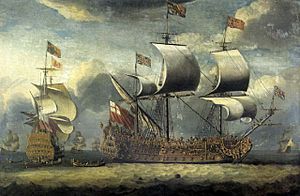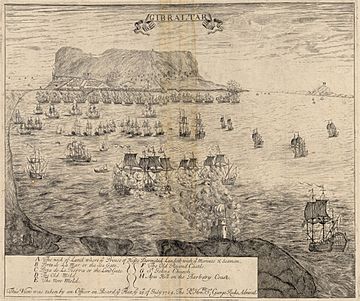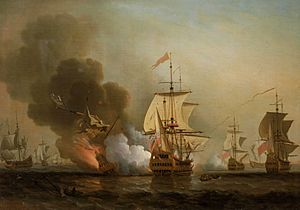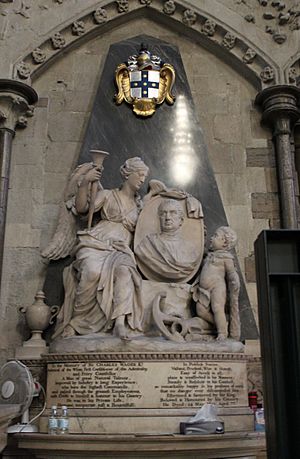Charles Wager facts for kids
Quick facts for kids
Sir Charles Wager
|
|
|---|---|

Portrait of Admiral Sir Charles Wager by Thomas Gibson
|
|
| Born | 24 February 1666 Rochester, Kent, England |
| Died | 24 May 1743 (aged 77) Stanley House, Chelsea, England |
| Allegiance | Kingdom of Great Britain |
| Service/ |
Royal Navy |
| Rank | Admiral of the White |
| Commands held | Samuel and Henry Newcastle Woolwich Greenwich Medway Hampton Court Jamaica Station Baltic Fleet |
| Battles/wars | War of the Spanish Succession Anglo-Spanish War |
Sir Charles Wager (born February 24, 1666 – died May 24, 1743) was an important officer in the Royal Navy and a politician in Great Britain. He held a very high position called First Lord of the Admiralty from 1733 to 1742. This meant he was in charge of the entire British navy.
Wager was known for his brave service at sea and his strong leadership. He also helped with important diplomatic tasks. During his time, the Royal Navy was stronger than ever before compared to other navies. It had excellent shipyards and bases around the world, especially in the Caribbean, which Wager helped develop. Even though British warships were sometimes not as well-designed as French ones, Wager worked to improve the fleet.
Contents
Early Life and Family
Charles Wager was born in Rochester, Kent, England, on February 24, 1666. His father, Captain Charles Wager, was also a naval officer who served in the navy of the Commonwealth. His mother, Prudence, was the daughter of Vice-Admiral William Goodsonn, another famous naval officer. Wager once said, "On both sides I am related to the navy," showing his strong family connection to the sea.
His father was a respected and well-liked officer. The famous diarist Samuel Pepys described him as "A brave, stout fellow." After his father died, Charles's mother remarried Alexander Parker, a Quaker merchant from London.
Learning to Sail
Young Charles Wager became an apprentice to a Quaker merchant captain named John Hull from Barnstable, Massachusetts. Hull ran a shipping business that sailed across the Atlantic. Wager's mother even witnessed Hull's marriage in London. It was during this time that Wager showed his strong character.
On one trip, their ship was attacked by a French privateer. Captain Hull, being a Quaker, could not fight due to his religious beliefs. But he also didn't want to give up his valuable ship. So, he turned to Wager. The young Wager didn't share Hull's religious views about fighting. He bravely took on the French ship and forced it to sail away. This event showed his courage and skill, which later caught the attention of the Royal Navy.
Wager's first official record in the navy is from August 1, 1689, when he was a lieutenant on the frigate Foresight. By 1691, he was the first lieutenant on the Dreadnought. In December of that year, he married Martha Earning. Her father was also a navy captain who later worked for the East India Company.
In 1692, Wager served on the Britannia, which was Admiral Edward Russell's main ship. He took part in the Battle of Barfleur and was promoted to post captain on June 7.
Commanding Ships
Over the next few years, Wager commanded several ships:
- In 1693, he was captain of the Samuel and Henry, protecting trade ships.
- In 1694, he commanded the Newcastle.
- From 1695 to 1699, he was on the Woolwich and then the Greenwich. On the Greenwich, he led a small group of ships protecting tobacco trade from the Chesapeake.
In 1701, he was appointed to the Medway. When the War of the Spanish Succession began in 1702, he became captain of the Hampton Court (70 guns) for the next five years.
Battles and Diplomacy
Wager's ship, the Hampton Court, was part of the fleet that captured Gibraltar in 1704. He also helped capture Barcelona in 1705 and defend it in 1706. He even helped negotiate a treaty with the Dey of Algiers.
Wager's Action
In 1707, Wager was sent to the Jamaica station in the Caribbean. He was in command of a squadron of ships. He learned that Spanish treasure ships, carrying silver from Peru, might be sailing near Cartagena.
On May 23, 1708, Wager's ships, including the Expedition, Kingston, and Portland, found the Spanish fleet. In a battle known as Wager's Action, one Spanish treasure ship was destroyed, and another was captured. The captured ship was full of silver, making Wager a very rich man.
This victory made him a hero. He was promoted to rear-admiral in November 1707 and knighted on December 8, 1709. He was also elected to Parliament in 1710, representing Portsmouth.
Admiral and Diplomat
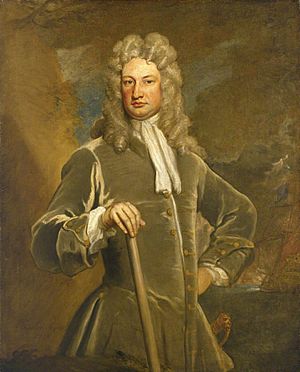
Even though the political party he supported, the Whigs, lost power in 1710, Wager was still re-elected to Parliament. He later represented West Looe from 1713 to 1715.
After Queen Anne died, Wager was put in charge of ships at Portsmouth. He later became the Comptroller of the Navy and then joined the Board of Admiralty in 1718. He stayed on the Board for 24 years, almost until the end of his life.
Leading the Baltic Fleet
In 1726, Wager was given command of a large British fleet sent to the Baltic to protect Sweden and Denmark from a powerful Russian fleet. He worked with the Danish navy and then took his twenty warships to Reval. His orders were to attack the Russian fleet if it left port. The Russian empress was so frustrated that she had to send her fleet home instead. Wager's actions showed he was not only a great admiral but also a skilled diplomat.
Protecting Gibraltar
In 1727, Wager was sent to Gibraltar with six warships. Spain was attacking Gibraltar, and Wager's fleet helped protect the land and ensured the British troops had supplies. He stayed there for sixteen months, helping to defend the important British base.
The "Stay-at-Home Fleet"
In 1729, Wager was ordered to command a huge fleet of 33 British ships, joined by 14 Dutch ships, at Spithead. This fleet was nicknamed the "stay-at-home fleet" because it never left port. It was assembled to show Spain that Britain was ready to fight if Spain didn't sign a peace treaty. The fleet's presence helped convince Spain to sign the treaty.
Mission to Italy
In 1731, Wager's flag was raised on the Namur. He led a British fleet to Cadiz Bay and then into the Mediterranean. Their mission was to support Spain in landing troops in Leghorn, Italy, as part of a new treaty. The mission went smoothly, and Wager returned to England in December 1731.
Between 1726 and 1731, Wager spent a lot of time at sea, carrying out important naval and diplomatic missions. His success in these roles showed his great skills. In May 1730, he was promoted to First Naval Lord on the Admiralty Board.
First Lord of the Admiralty
In January 1733, the head of the navy, Lord Torrington, died. Everyone expected Sir Charles Wager to take his place because of his knowledge and talent. He was officially appointed First Lord of the Admiralty on June 21, 1733. That same year, he became a member of His Majesty's Privy Council, a group of important advisors to the King. He was also elected as a Member of Parliament for Westminster in 1734.
Wager was a trusted and respected admiral. He was known for being fair and professional. For example, he strongly argued that Edward Vernon should be given command in the West Indies, even though Vernon often disagreed with him in Parliament. Wager was a loyal friend and spokesman for Sir Robert Walpole, the Prime Minister. People often asked Wager for his opinion on sea travel, trade, and colonies because he was so knowledgeable.
One of the biggest problems during Wager's time as First Lord was finding enough sailors for the fleet. In 1731, he noted that "we have no difficulty but in getting men." He explained that because Britain was a "free Country," it was hard to force people to join the navy.
When the War of Jenkins' Ear started in 1739, this problem became even worse. Wager tried to get new laws passed to help recruit more sailors, but Parliament didn't pass anything strong enough.
War in the West Indies
The government decided to attack Spain in the West Indies. This meant sending a large fleet and army to a region where tropical diseases were common. Wager was worried because he knew how dangerous the climate could be. He preferred to attack the Peruvian coast from the "South Sea." This idea led to the famous voyage of Commodore George Anson, who sailed around the world starting in 1740.
Before the expedition to the West Indies even left England, a severe typhus sickness spread through the fleet in 1740. This made the problem of finding enough healthy sailors much worse and delayed the ships. As Wager feared, the attack on Cartagena failed, mainly because many soldiers and sailors got sick from tropical diseases.
Reputation and Final Years
Some people later claimed that the navy was not ready for war in 1739 and that Wager was too old and incompetent. However, these claims seem unlikely. Wager was still very active and spoke strongly in Parliament even at 74 years old. He even commanded the King's channel crossings in 1740 and 1741, and once saved the King's group by turning back in a storm.
Wager's popularity was so high that it accidentally caused a problem during the Westminster election in 1741. He was commanding the King's voyage, which happened at the same time as the election. His absence might have allowed Edward Vernon to be nominated as a candidate without his knowledge. This election chaos contributed to Prime Minister Walpole losing control in Parliament. When Walpole decided to leave office, Wager also resigned as First Lord in January 1742.
Retirement and Death
In December 1742, Wager was given the job of Treasurer of the Navy, which was a good way for him to receive a pension. He remained in Parliament, representing West Looe. He died peacefully at Stanley House, Chelsea, on May 24, 1743. He was buried in Westminster Abbey on May 30, 1743.
In 1747, a monument was built for him in Westminster Abbey by sculptor Peter Scheemakers. It shows his famous naval battle where he destroyed and captured Spanish treasure ships in 1708. Lady Wager died in 1748 and was buried next to him.
Wager and his wife had no children, but he helped many of his relatives financially.
Philanthropy
Wager was known for his generosity. He helped many individuals in need and supported charity organizations. For example, he was a patron of the "Cockney Feast" in London, a charitable event. An inscription on a church bell in St Dunstan's, Stepney mentions his support for this feast.
Legacy
When Wager died, Horace Walpole said he "left the fairest character," meaning he was highly respected. Arthur Onslow, a respected speaker of the Commons, described Wager as "the most gentle and humane disposition I ever knew." He said Wager was calm, brave, and had a very good understanding. Onslow also noted that Wager's upbringing among Quakers gave him a simple manner and speech.
In Popular Culture
The actor Frank Finlay played Charles Wager in the Channel 4 TV series, Longitude in 2000.
Recognition
A British warship, HMS Wager, was named after Charles Wager. Also, Wager Island is named after him. This island became famous as the location of the Wager Mutiny, where some of Anson's crew were shipwrecked.
Images for kids
-
Portrait of Admiral Sir Charles Wager by Thomas Gibson
-
Sir Charles Wager by Godfrey Kneller


